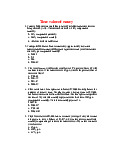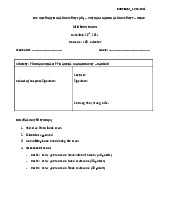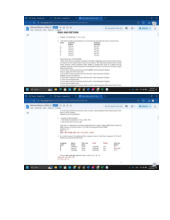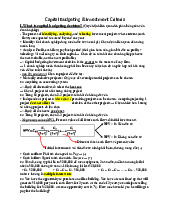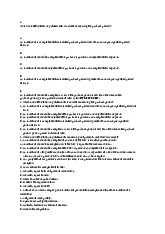





Preview text:
lOMoAR cPSD| 58562220 Le Do Mai Oanh
FM MULTIPLE CHOICE QUESTIONS
1. To compute the required rate of return for equity in a company using the CAPM, it is necessary
to know all of the following EXCEPT: A. the risk-free rate. B. the beta for the firm.
C. the beta of the market portfolio
D. the market return expected for the time period.
2. In calculating the costs of the individual components of a firm's financing, the corporate tax rate
is important to which of the following component cost formulas? A. common stock. B. debt. C. preferred stock. D. none of the above.
3. The common stock of a company must provide a higher expected return than the debt of the same company because
A. there is less demand for stock than for bonds.
B. there is greater demand for stock than for bonds.
C. there is more systematic risk involved for the common stock.
D. there is a market premium required for bonds.
4. For an all-equity financed firm, a project whose expected rate of return plots………should be rejected.
A. above the characteristic line
B. above the security market line
C. below the security market line
D. below the characteristic line
5. Lei-Feng, Inc.'s $100 par value preferred stock just paid its $10 per share annual dividend. The
preferred stock has a current market price of $96 a share. The firm's marginal tax rate (combined
federal and state) is 40 percent, and the firm plans to maintain its current capital structure
relationship into the future. The component cost of preferred stock to Lei-Feng, Inc. would be closest to . A. 6 percent B. 6.25 percent C. 10 percent D. 10.4 percent
6. David Ding is evaluating two conventional, independent capital budgeting projects (X and Y).
Projects X and Y have internal rates of return of 16 percent and 12 percent, respectively. The
discount rate of Project X is 18 percent, while Project Y's discount rate is only 10 percent. The
company's overall, weighted-average cost of capital is 14 percent. David should .
A. accept Project X and accept Project Y lOMoAR cPSD| 58562220 Le Do Mai Oanh
B. accept Project X and reject Project Y
C. reject Project X and accept Project Y
D. reject Project X and reject Project Y 7. The pre-tax cost of debt:
A. is based on the current yield to maturity of the firm's outstanding bonds.
B. is equal to the coupon rate on the latest bonds issued by a firm.
C. is equivalent to the average current yield on all of a firm's outstanding bonds.
D. is based on the original yield to maturity on the latest bonds issued by a firm.
8. The cost of preferred stock is computed the same as the: A. pre-tax cost of debt. B. return on an annuity. C. aftertax cost of debt. D. return on a perpetuity.
9. Chelsea Fashions is expected to pay an annual dividend of $0.80 a share next year. The market
price of the stock is $22.40 and the growth rate is 5 percent. What is the firm's cost of equity? A. 7.58 percent B. 7.91 percent C. 8.24 percent D. 8.57 percent
10. The Shoe Outlet has paid annual dividends of $0.65, $0.6825, $0.7166, and $0.7524 per share
over the last four years, respectively. The stock is currently selling for $26 a share. What is this
firm's cost of equity? Choose the closet figure: A. 7 percent B. 7 percent C. 8 percent D. 10 percent lOMoAR cPSD| 58562220 Le Do Mai Oanh
11. You own a stock that you think will produce a return of 11 percent in a good economy and 3
percent in a poor economy. Given the probabilities of each state of the economy occurring is equal,
you anticipate that your stock will earn 7 percent next year. Which one of the following terms applies to this 7 percent? A. arithmetic return B. historical return C. expected return D. required return
12. Which one of the following is a risk that applies to most securities? A. unsystematic risk B. diversifiable risk C. systematic risk D. total risk
13. A news flash just appeared that caused about a dozen stocks to suddenly drop in value by about
20 percent. What type of risk does this news flash represent? A. unsystematic risk B. diversifiable risk C. systematic risk D. total risk
14. The principle of diversification tells us that:
A. concentrating an investment in three companies all within the same industry will greatly reduce the systematic risk.
B. spreading an investment across five diverse companies will not lower the total risk.
C. spreading an investment across many diverse assets will eliminate all of the systematic risk.
D. spreading an investment across many diverse assets will eliminate some of the total risk.
15. Which one of the following is represented by the slope of the security market line? lOMoAR cPSD| 58562220 Le Do Mai Oanh A. reward-to-risk ratio B. market standard deviation C. beta coefficient D. market risk premium
16. According to CAPM, the amount of reward an investor receives for bearing the risk of an
individual security depends upon the:
A. amount of total risk assumed and the market risk premium.
B. market risk premium and the amount of systematic risk inherent in the security.
C. risk free rate, the market rate of return, and the standard deviation of the security.
D. beta of the security and the market rate of return.
17. You want your portfolio beta to be 0.95. Currently, your portfolio consists of $4,000 invested
in stock A with a beta of 1.47 and $3,000 in stock B with a beta of 0.54. You have another $9,000
to invest and want to divide it between an asset with a beta of 1.74 and a risk-free asset. How much
should you invest in the risk-free asset? A. $4,316.08 B. $4,425.29 C. $4,902.29 D. $4,574.71
18. Jerilu Markets has a beta of 1.09. The risk-free rate of return is 2.75 percent and the market
rate of return is 9.80 percent. What is the risk premium on this stock? A. 6.47 percent B. 7.03 percent C. 7.68 percent D. 8.99 percent
19. Your portfolio has a beta of 1.12. The portfolio consists of 20 percent U.S. Treasury bills, 50
percent stock A, and 30 percent stock B. Stock A has a risk-level equivalent to that of the overall
market. What is the beta of stock B? lOMoAR cPSD| 58562220 Le Do Mai Oanh A. 1.47 B. 1.52 C. 1.69 D. 2.07
20. Which one of the following is an example of unsystematic risk?
A. income taxes are increased across the board
B. a national sales tax is adopted
C. inflation decreases at the national level
D. consumer spending on entertainment decreased nationally KEY lOMoAR cPSD| 58562220 Le Do Mai Oanh 1. C 2. B 3. C
4. C since this project has lower return given the same risk compared to market. 5. D
6. C since IRR(X) reject; IRR(Y)>discount rate(Y)=> accept 7. A 8. D 9. D 10. C 11. C 12. C 13. A 14. D 15. D 16. B 17. D
Beta(Portfolio) = 0.95 = ($4,000/$16,000)(1.47) + ($3,000/$16,000)(0.54) +
(x/$16,000)(1.74) + (($9,000 - x)/$16,000)(0)
Investment in risk-free asset = $9,000 - $4,425.29 = $4,574.71 18. C
Risk premium = 1.09 (0.098 - 0.0275) = 7.68% 19. D 20. D
